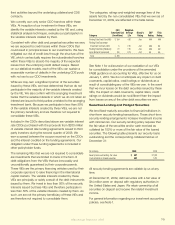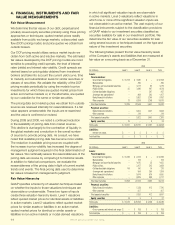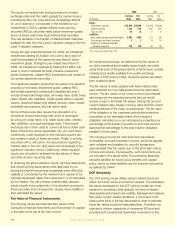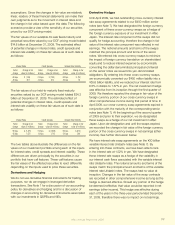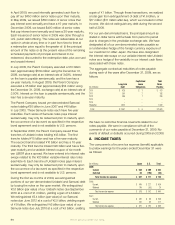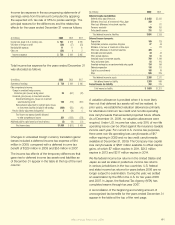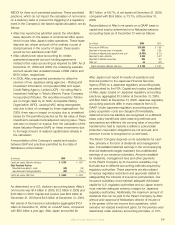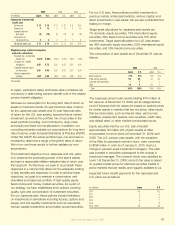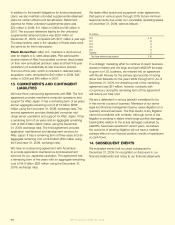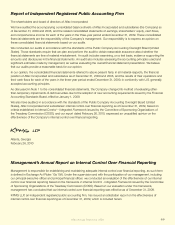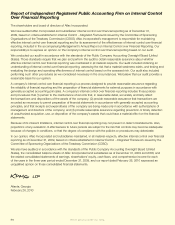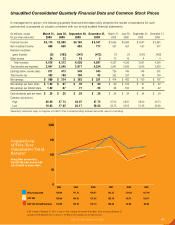Aflac 2009 Annual Report Download - page 87
Download and view the complete annual report
Please find page 87 of the 2009 Aflac annual report below. You can navigate through the pages in the report by either clicking on the pages listed below, or by using the keyword search tool below to find specific information within the annual report.
termination date of February 18, 2009, we paid $825 million
to GS&Co. for the repurchase of a variable number of shares
of our outstanding common stock over the stated contract
period. The repurchase was funded with internal capital. As
of September 30, 2008, the $825 million remitted to GS&Co.
under the agreement was reected as a reduction to
additional paid-in capital pending receipt of treasury shares
purchased in connection with the agreement. On October
2, 2008, due to market conditions, we took early delivery
of 10.7 million shares, which we hold in treasury, at a total
purchase price of $683 million, or $63.87 per share. We also
received unused funds of $142 million from GS&Co.
As of December 31, 2009, a remaining balance of 32.4
million shares of our common stock was available for
purchase under share repurchase authorizations by our
board of directors. The 32.4 million shares were comprised
of 2.4 million shares remaining from a board authorization
in 2006 and 30.0 million shares remaining from an
authorization by the board of directors for purchase in 2008.
Voting Rights: In accordance with the Parent Company’s
articles of incorporation, shares of common stock are
generally entitled to one vote per share until they have been
held by the same benecial owner for a continuous period of
48 months, at which time they become entitled to 10 votes
per share.
10. SHARE-BASED TRANSACTIONS
As of December 31, 2009, the Company has outstanding
share-based awards under two long-term incentive
compensation plans.
The rst plan, which expired in February 2007, is a stock
option plan which allowed grants for incentive stock options
(ISOs) to employees and non-qualifying stock options
(NQSOs) to employees and non-employee directors. The
options have a term of 10 years and generally vest after
three years. The strike price of options granted under
this plan is equal to the fair market value of a share of the
Company’s common stock at the date of grant. Options
granted before the plan’s expiration date remain outstanding
in accordance with their terms.
The second long-term incentive compensation plan allows
awards to Company employees for ISOs, NQSOs, restricted
stock, restricted stock units, and stock appreciation rights.
Non-employee directors are eligible for grants of NQSOs,
restricted stock, and stock appreciation rights. Generally,
the awards vest based upon time-based conditions or time-
and performance-based conditions. Performance-based
vesting conditions generally include the attainment of goals
related to Company nancial performance. As of December
31, 2009, approximately 18.0 million shares were available
for future grants under this plan, and the only performance-
based awards issued and outstanding were restricted stock
awards.
Share-based awards granted to U.S.-based grantees are
settled with authorized but unissued Company stock, while
those issued to Japan-based grantees are settled with
treasury shares.
The following table presents the expense recognized in
connection with share-based awards for the periods ended
December 31.
(In millions, except for per-share amounts) 2009 2008 2007
Earnings from continuing operations $ 38 $ 42 $ 42
Earnings before income taxes 38 42 42
Net earnings 27 29 29
Net earnings per share:
Basic $ .06 $ .06 $ .06
Diluted .06 .06 .06
We estimate the fair value of each stock option granted
using the Black-Scholes-Merton multiple option approach.
Expected volatility is based on historical periods generally
commensurate with the estimated terms of the options.
We use historical data to estimate option exercise and
termination patterns within the model. Separate groups of
employees that have similar historical exercise patterns are
stratied and considered separately for valuation purposes.
The expected term of options granted is derived from the
output of our option model and represents the weighted-
average period of time that options granted are expected
to be outstanding. We base the risk-free interest rate on
the Treasury note rate with a term comparable to that of
the estimated term of the options. The weighted-average
fair value of options at their grant date was $8.89 for 2009,
compared with $17.21 for 2008 and $16.06 in 2007. The
following table presents the assumptions used in valuing
options granted during the years ended December 31.
2009 2008 2007
Expected term (years) 6.6 7.0 7.4
Expected volatility 32.0% 25.0% 25.0%
Annual forfeiture rate 1.6 .8 .8
Risk-free interest rate 3.2 3.5 4.7
Dividend yield 1.3 1.3 1.3
The table at the top of the following page summarizes stock
option activity.
Aflac Annual Report for 2009 83


